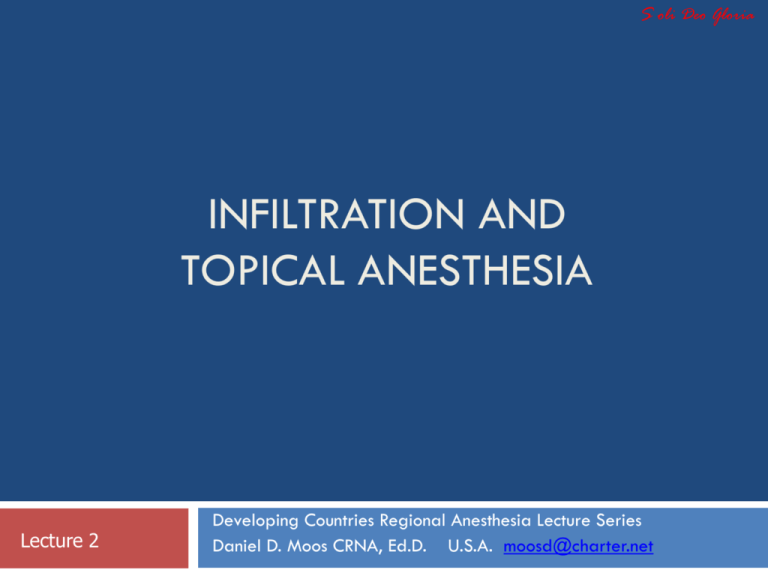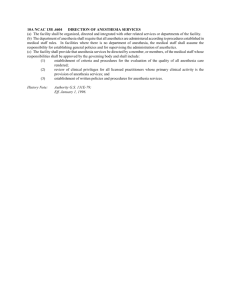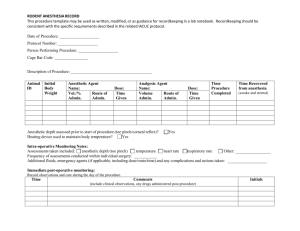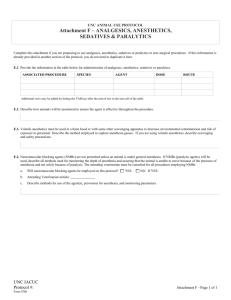Infiltration, Topical, and Tumescent Anesthesia
advertisement

S oli Deo Gloria INFILTRATION AND TOPICAL ANESTHESIA Lecture 2 Developing Countries Regional Anesthesia Lecture Series Daniel D. Moos CRNA, Ed.D. U.S.A. moosd@charter.net Disclaimer Every effort was made to ensure that material and information contained in this presentation are correct and up-to-date. The author can not accept liability/responsibility from errors that may occur from the use of this information. It is up to each clinician to ensure that they provide safe anesthetic care to their patients. Infiltration Anesthesia/Analgesia Need to know maximum doses for the surgeon Need to know maximum doses if we need to supplement a block Need to know maximum dose plain and with epinephrine Infiltration Anesthesia/Analgesia Most local anesthetics can be used for infiltration anesthesia Immediate onset for intradermal or subcutaneous administration Epinephrine will prolong duration of action of all local anesthetics Pain with injection is noted due to the acidic nature of local anesthetic solutions Maximum Dose Plain Amides Local Anesthetic Concentration in % Maximum Dose Total Maximum Dose mg/kg Duration of Action Lidocaine 0.5-1 300 4.5 30-60 minutes Moderate duration Mepivacaine 0.5-1 300 4.5 45-90 minutes Moderate duration Bupivacaine 0.25-0.5 175 2.5 120-240 minutes Long duration Ropivacaine 0.1-2 200 3 120-360 minutes Long duration Note: there is a total maximum dose regardless of weight as well as a mg/kg dose. Maximum Dose with Epinephrine Amides Local Anesthetic Concentration in % Maximum Dose Total Maximum Dose mg/kg Duration of Action Lidocaine 0.5-1 500 7 120-360 minutes Moderate duration Mepivacaine 0.5-1 500 7 120-360 minutes Moderate duration Bupivacaine 0.25-0.5 225 3 180-420 minutes Long duration Note: there is a total maximum dose regardless of weight as well as a mg/kg dose. Maximum Doses- Where is the evidence? Maximum doses are based on manufacturer recommendations, animal studies, and case reports. Maximum doses vary by country. Rosenberg et. al. (2004). Maximum recommended doses of local anesthetics: a multifactoral concept. Regional Anesthesia, 29, 564-575. Maximum doses by country Local Anesthetic Finland Sweden United States Bupivacaine plain 175 mg 150 mg 175 mg Lidocaine plain 200 mg 200 mg 300 mg Mepivacaine with epinephrine None listed 350 mg 550 mg Ropivacaine 225 mg 200 mg 225 mg Adopted from Rosenberg et. al., 2004 Maximum Doses- Where is the evidence? Animal studies are used to identify quantal doseeffect curves to determine median effective doses (ED50) and median toxic dose (TD50). Maximum Doses- Where is the evidence? Therapeutic index is derived as a ratio of TD50 and ED50. Problem with animal studies is they do not accurately replicate the complexities found within human populations. Rosenberg et. al. (2004). Maximum recommended doses of local anesthetics: a multifactoral concept. Regional Anesthesia, 29, 564-575. Maximum Doses- Where is the evidence? What impacts toxic doses of local anesthetics and subsequent plasma concentrations? Site of administration- direct impact as noted earlier. Use of vasoconstrictors- decreases absorption but is dependent upon specific local anesthetic used and site of administration. Disease processes- directly impact plasma concentrations of local anesthetics. Rosenberg et. al. (2004). Maximum recommended doses of local anesthetics: a multifactoral concept. Regional Anesthesia, 29, 564-575. Example of hyperdynamic circulations impact on local anesthetics…i.e. uremia/pregnancy Peak concentrations occur earlier and result in higher concentrations of local anesthetics Hyperdynamic Circulation Enhanced local uptake of local anesthetic Rosenberg et. al. (2004). Maximum recommended doses of local anesthetics: a multifactoral concept. Regional Anesthesia, 29, 564-575. Maximum Doses- Where is the evidence? Based on these observations maximum dose recommendations have been called into question. Attempts are being made to create recommendations based on age, renal, hepatic, cardiac diseases, and pregnancy. Poor quality of data (case series, cohort studies) have hindered creating specific recommendations at this time. Rosenberg et. al. (2004). Maximum recommended doses of local anesthetics: a multifactoral concept. Regional Anesthesia, 29, 564-575. Maximum Doses- Where is the evidence? Until better evidence is available the anesthesia provider should ‘stick’ with current recommendations. Topical Anesthesia Topical Anesthesia Lidocaine Dibucaine Tetracaine Benzocaine EMLA Topical Anesthesia Effective, short term analgesia Applied to mucous membranes, intact skin, and abraded skin EMLA Cream EMLA Mixture of 2.5% lidocaine and 2.5% prilocaine Risk of methemoglobinemia is rare Safe in neonates Effective in anesthetizing the skin for cannulation and skin grafts Must be applied under an occlusive dressing for 4560 minutes TAC 0.5% tetracaine 1:200,000 epinephrine 10-11.8% cocaine TAC Safe on skin Not safe on mucous membranes due to rapid absorption and risk of toxicity Max dose for adults is 3-4 ml Max dose peds is 0.05 ml/kg Concern about the cocaine component LET Lidocaine Epinephrine Tetracaine LET Alternative to TAC (no cocaine) More dilute preparations in peds Addition of Phenylephrine or Oxymetazoline Large amounts of phenylephrine on mucous membranes can lead to HTN and reflex bradycardia Oxymetazoline has a larger safety of margin Methemoglobinemia & Benzocaine Benzocaine application can result in the potentially fatal complication of methemoglobinemia (MHb) As an anesthesia provider you may called to assist in airway management in another department (i.e. endoscopy, CV with TEE) As an anesthesia provider you may encounter this complication when applying local anesthetic to mucous membranes in preparation to perform a fiberoptic intubation Recognition of this complication is important Methemoglobinemia & Benzocaine Benzocaine is the most commonly implicated local anesthetic in the development of MHb. Incidence: 1:7,000 exposures Up to 35% of benzocaine that is applied to mucous membranes is absorbed systemically. Problems with Benzocaine Application Hard to estimate the dose that is actually administered Application should be for 1 second or less 46.4% of the cases of MHb associated with benzocaine reported to the FDA had more than 1 spray administered or longer than 1 second spray. MHb brief pathophysiology Hemoglobin contains 4 heme groups (Fe+2) on the surface of the molecule. MHb is a form of hemoglobin that is unable to bind with O2 Benzocaine can oxidize Fe+2 to Fe+3. Since MHb is unable to bind with O2 there is a diminished ability to deliver O2 to tissue. Signs and Symptoms of MHb are Dependent Upon the Levels of MHb Patients with anemia and CV disease may demonstrate S+S earlier 10% MHb cyanosis 15% MHb cyanosis, headache, weakness, dizziness, lethargy, & tachycardia 10-20% levels are generally well tolerated 45% dyspnea, cyanosis, seizures, coma, dysrhymias, & heart failure 70% mortality can occur MHb Diagnosis Suspected in any patient that develops cyanosis after the administration of topical pharyngeal anesthesia in which supplemental oxygen does not improve the patients symptoms. SA02 is inaccurate, reading may range from 8085% regardless of what the MHb % content is. Inaccuracies occur when the MHb level is > 10% MHb Diagnosis Co-oximetry is able to dx the levels of MHb. This is the gold standard for dx and is available with most ABG determinations (but not all) Request it when sending the lab sample MHb Treatment Must first confirm presence of MHb Methylene blue 1-2 mg/kg IVP over 5 minutes Methylene blue accelerates the capacity of NADPH MHb reductase to reduce MHb to normal hemoglobin Side effects of methylene blue include dizziness, confusion, restlessness, headache, abdominal pain, nausea and vomiting, dyspnea, hyper or hypotension, & diaphoresis. MHb Treatment Methylene blue will not help in patients with G-6 deficiency, NADPH Mhb, cytochrome b5 reductase deficiency. It should be avoided in these patients. If the patients condition improves then the patient needs to monitored for reoccurrence. A 2nd dose can be administered in 1 hour. Total dose should not exceed 7 mg/kg since methylene blue can result in the formation of MHb Practical Applications Practical Applications References Bourne, H.R. & Roberts, J.M. (1992). Drug Receptors & Pharmacodynamics. In B.G. Katzung (editor) Basic & Clinical Pharmacology. Norwalk, Connecticut: Appleton & Lange. Heavner, J.E. (2008). Pharmacology of local anesthetics. In D.E. Longnecker et al (eds) Anesthesiology. New York: McGraw-Hill Medical. Moos, D.D. & Cuddeford, J.D. (2007). Methemoglobinemia and benzocaine. Gastroenterology Nursing, 30, 342-345. Morgan, G.E., Mikhail, M.S., Murray, M.J. (2006). Local anesthetics. In G.E. Morgan et al Clinical Anesthesiology, 4th edition. New York: Lange Medical Books. Rosenberg, P.H., Veering, B.Th., Urmey, W.F. (2004). Maximum recommended doses of local anesthetics: a multifactorial concept. Regional Anesthesia, 29, 564-575. Strichartz, G.R. & Berde, C.B. (2005). Local Anesthetics. In R.D. Miller Miller’s Anesthesia, 6th edition. Philadelphia: Elsevier Churchill Livingstone. Wedel, D.J. & Horlocker, T.T. (2008). Peripheral Nerve Blocks. In D.E. Longnecker et al (eds) Anesthesiology. New York: McGraw-Hill Medical.






